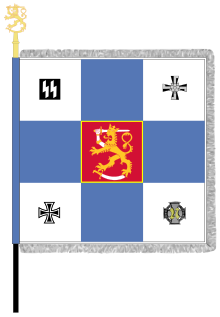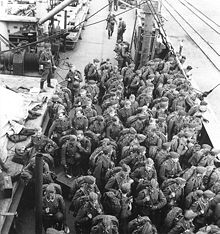Finnish volunteer battalion of the Waffen SS
In May 1941, was Finnish Volunteer Battalion of the Waffen-SS in the framework of the 5th SS Panzer Division "Wiking" on the German-Soviet war participated erected. Immediately after the German invasion of the Soviet Union , Finland began the Continuation War to recapture the areas of Karelia that had previously been lost in the Winter War . Until the autumn of 1944, the Finnish army faced considerable Soviet forces in a long stretch of the front. The battalion was required and recalled by the Finnish government in May 1943 after the agreed two-year contract period for the volunteers had expired. Between 1941 and 1943, more than 1,500 Finnish volunteers served in the Waffen SS . Individual Finnish volunteers continued their work in the 11th SS Volunteer Panzer Grenadier Division "Nordland" even after the recall in May 1943 .
Origin and background
After long negotiations, the Finnish government permitted Finnish citizens to be recruited into the Waffen SS in the spring of 1941 . A first group of 116 volunteers, most of whom had already fought against the Soviet Union in the winter war of 1939/1940 , came to Germany in May 1941 and formed the core of the Finnish Volunteer Battalion Northeast . Until the war against the Soviet Union on June 22, 1941, the strength of the battalion grew to over 400 men who belonged to the SS division Wiking. Further recruitment in the second half of the year increased the number of Finns in the Waffen SS to over 1,100 men. On October 15, 1941, one month after the battalion was renamed "Finnish Volunteer Battalion of the Waffen-SS", the unit received its troop flag .
Cooperation with the Finnish government enabled not only service in the volunteer battalion in Finland to be counted as military service, but also the use of active soldiers and officers in the Finnish army . Since the formation of a motorized infantry regiment was originally intended, which, in contrast to other volunteer units of the Waffen-SS, was to be commanded exclusively by Finns, the number of officers and non-commissioned officers was significantly higher than that required for a battalion.
In order to consolidate the common brotherhood in arms, the battalion was placed in the tradition of the Royal Prussian Jäger Battalion No. 27 , which had been formed from Finns in 1916 for the fight against Russia and formed the core of the Finnish army in 1918.
commitment
The Finnish Volunteer Battalion reached the front in Ukraine in January 1942 in the area of Army Group South , where it was assigned to the SS Regiment "Nordland" as the fourth battalion of the SS Wiking Division. With the Wiking Division, the battalion took part in Operation Blau , the advance on Stalingrad and the oil regions in the Caucasus .
Losses and whereabouts
The number of fallen Finnish volunteers is given as 256, not counting those who continued to serve in the Waffen SS after 1943. The survivors left the front in May 1943 in the direction of Auerbach Grafenwöhr (Bavaria), where the Nordland regiment was disbanded. The farewell ceremony of the Finnish Volunteer Battalion took place on May 23, 1943 in Ruhpolding. The returnees reached Hanko (Finland) on June 2, 1943 and were reintegrated into the Finnish army after the final dissolution of their battalion (July 11, 1943).
literature
- George H. Stein and H. Peter Krosby: The Finnish volunteer battalion of the Waffen-SS. A study on SS diplomacy and the foreign volunteer movement . In: " Vierteljahrshefte für Zeitgeschichte ", Vol. 14, Issue 4 from 1966, pp. 413–453. ( Essay online )

